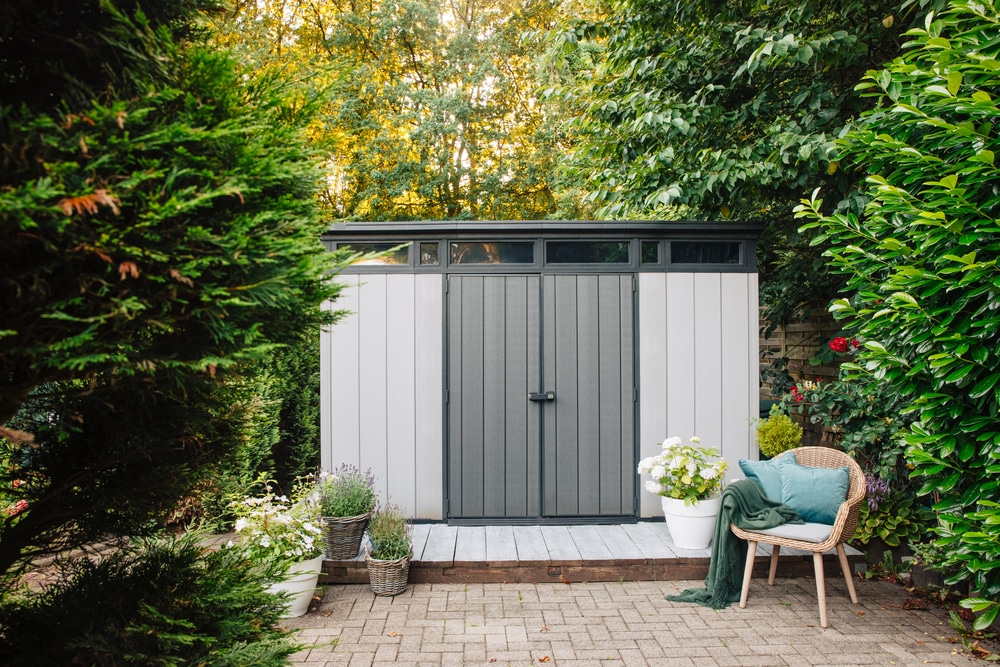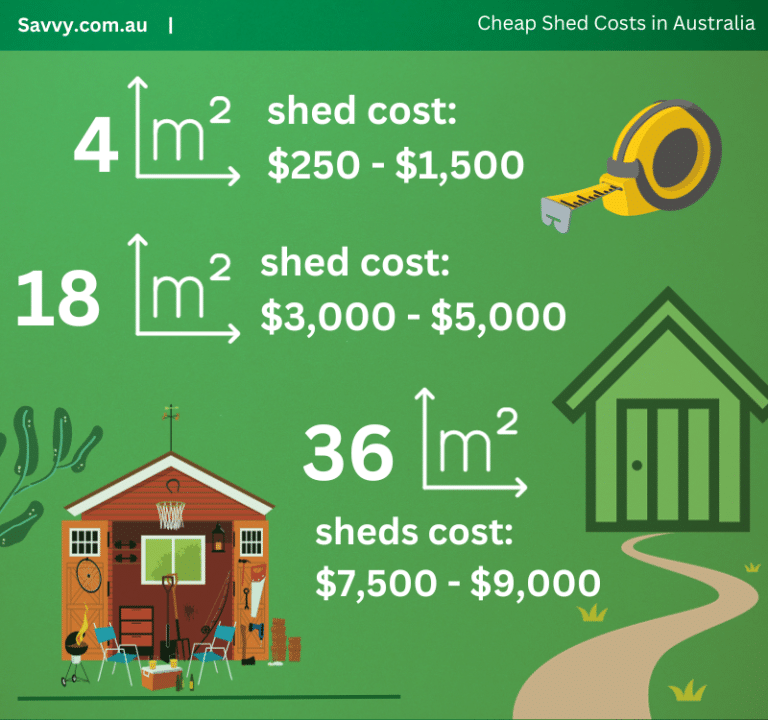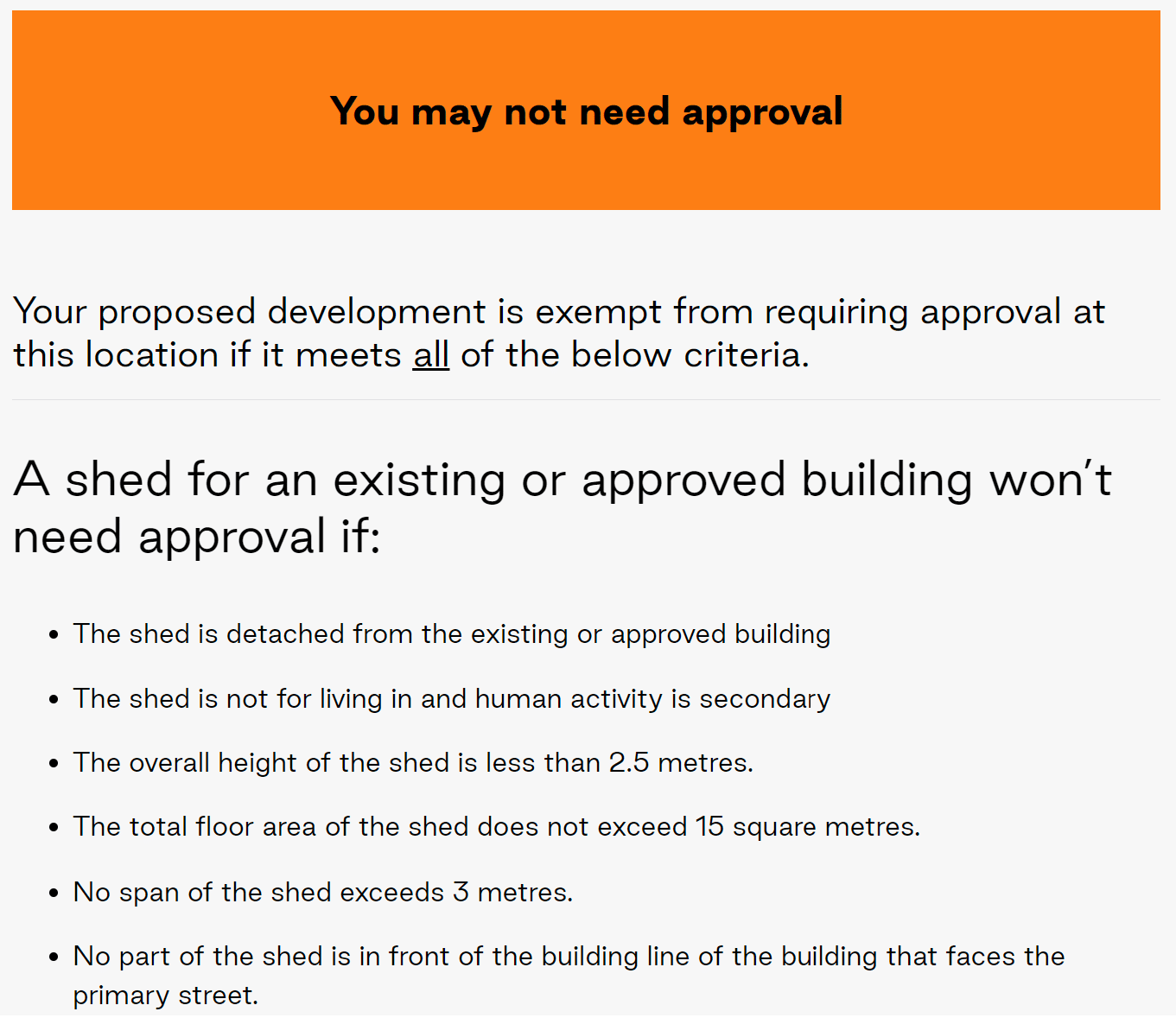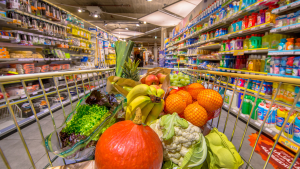
- The Savvy Promise
At Savvy, our mission is to empower you to make informed financial choices. While we maintain stringent editorial standards, this article may include mentions of products offered by our partners. Here’s how we generate income.
In this article
One of the mainstays in Australian homes with a yard is the humble yet indispensable garden shed. Garden sheds have become a place where toys get fixed (for kids and dad), DIY projects are born, old memories are stored, and perhaps a few beers are cracked with mates in a “man cave.” No matter the reason for wanting or building a shed, a shed can have many uses – especially larger residential sheds that fit within the usual quarter-acre block.
- 2×2 metre square sheds range in price from $250 – $1,500, depending on materials
- 6×3 metre square sheds cost between $3,000 and $5,000
- You should check your local state and council guidelines first before building
- A shed may not need approval if: less than 2.5m high, does not exceed 15m2, no span exceeds 3m
If you’re new to this brave new shed world, we gather all the information about placing a shed, building your own shed, what materials sheds can come in, and whether or not council permits are required, especially if they insist upon professional shed installation on your property.

The cost of a typical garden shed
Garden shed or residential shed prices can vary due to many factors. These can range from how large the shed is, what materials they are made from, the type of roof you select, the use case, whether your property is in a suburban or regional area, and if the shed is for residential or farm use.
Looking at over 10 different shed catalogues from around Australia, the consensus is that the smallest shed one can purchase is a 2x2m or 4m2 kit, starting at about $250. These can be purchased from hardware stores such as Bunnings or Mitre 10. A more durable steel/Zincalume kit can range from about $500 to $1000.
These small garden sheds are suitable for storing garden tools and non-perishable goods. The upside is that these classical garden sheds are easy to install – and you can get them up and done by yourself within an afternoon.
However, if one needs a walk-in shed or a workshop style shed, these costs can jump up considerably, due to the complexity of construction involved.
A medium-sized residential shed of 6mx6m or 36m2 made from basic plastic or Zincalume can cost anywhere between $7,500 and $9,000 with professional installation costs ranging from $400 and upwards.
Average shed prices in Australia
Shed Size (in metres) | Shed area | Use case | Average Price range |
2X2 | 4m2 | Small residential garden | $250 – $1,500 |
6×3 | 18m2 | Small residential workshop | $3,000-$5,000 |
6X6 | 36m2 | Medium sized residential | $7,500 – $9,000 |
9X6 | 54m2 | Medium/Large sized res | $9,500 – $10,500 |
12X6 | 72m2 | Large sized residential | $12,000 – $13,000 |
12X9 | 108m2 | Large sized residential/farm | $13,500 – $15,000 |
*Sheds over 10m2 do not include council or private certifier costs
These prices have greater ranges due to the materials being used and other factors such as roof style and concrete foundation requirements.
Shed materials
There are many different materials sheds can come in. Choosing the correct shed materials will depend on where you live and the use case of your shed. Local climate can also influence or narrow the types of materials you can reasonably build your shed from.
The most common shed material (and cheapest) is plastic, which is the most common form small kit sheds are built from (2x2m, for example.) Plastic sheds are unsuitable for hotter or wetter climates, as they may melt in extreme temperatures: or be blown away by wild winds such as cyclones.
The next best option to plastic is Steel or Metal – but may be susceptible to rust if not manufactured from stainless steel.
New innovations in steel sheds have improved rust protection. Zincalume, manufactured from magnesium, aluminium, and zinc compounds are engineered to slow corrosion and last four times as long as comparable metals.
As seen above, a small 2×2 Zincalume shed can cost twice as much as plastic ($250 vs $500.) Colourbond (a premium steel product compared to Zincalume) costs slightly more at about $600, while a shed constructed from wood or timber is the most premium option at $2,000.
In between metal and wood-based sheds are the less common resin sheds, which can start from $800 and go up to $4,000. These are made from Polyresin or Polycarbonate plastic and are highly resistant to weather, sunlight, and rot. They also require the least amount of maintenance.
Wooden sheds, on the other hand, need regular upkeep in the form of treatment or paint every few years to protect it from the elements.
Colourbond steel is a highly durable and versatile steel that is tested in Australian conditions, provides thermal protection and fire resistance. Colourbond is also available in 22 different colours. Colourbond steel is the most expensive option out of all previous ones listed. A Gable roof 2x2m Colourbond kit shed starts at a price of $620 but can often cost double this depending on your location.
For larger sheds (6x6m and up) plastic may not be a viable option. This means choosing from wood, metal, resin, Zincalume, or Colourbond.
Explore shed financing options here.
Planning requirements for sheds can vary between state and address

*Planning requirements for sheds can differ from address to address, as well as between different states or territories, so it's essential to check your with your local planning authority online before committing to a design or making a purchase.
Source: Plan.sa.gov.au/development_applications/getting_approval
Shed roofs
All the sheds mentioned above assume there is at least one door in the shed and perhaps a built-in window. This is not consistent with all shed kits or custom designs. Depending on where you live, you may need to select a certain type of shed roof.
A lean-to or Skillion roof is a single-slope roof which is easy to build and allows for greater rain runoff. However, the overhang can be troublesome if you live in high wind areas. The Slanted (pent) roof is an even steeper variant that is suitable for sheds that rest beside a garden wall or fence.
A flat roof is the most cost-effective roof on a shed and will ensure a low profile. Of course, it doesn’t shed rain as well as angled roofs and requires additional maintenance.
The most common roof style is the Gable roof which resembles a home roof – pitched and sloping on both sides with a peak in the centre. It allows for greater storage space, are easy to build, and provide additional ventilation. They are prone to damage in strong winds and may require planning permits from council (as they may be considered a granny flat or additional dwelling.) The Hip style roof is similar to a Gable but doesn’t have the same ends and are much more popular in Australia than in the US.
For those living in strong wind areas, the Saltbox Roof is the best choice due to its asymmetrical off-centre roof line. The downsides are that it compromises on storage space and more expensive than most other options.
The Gambrel or “barn-style” roof is a popular American style which has extra gussets connecting to the rafters. It too allows for greater rain shedding and extra storage capacity. Though strong, they are vulnerable in high winds and unsuitable for urban or suburban areas. They will also require special design and carpentry work, adding to your costs.
Other types of roofs (which are less common but still available) is the Octagon style where eight triangular sections join at a central point; a curved roof which combines the flat and Gable styles; the Jerkinhead which combines the hip and Gable styles; and the Mansard roof which takes elements from the Gambrel and hip style.https://www.savvy.com.au/car-loans/car-buying-research-preferences-survey/
David Webb, Head of Industry Revenue and Partnerships at Homely.com.au;
“Properties nationwide are on average decreasing in size, making storage an increasingly important factor for buyers and renters when deciding where to live. Whether a shed can boost a property's value is often quite specific to the property itself, yet it's one of those features that might tip a buyer's preference from one property to another. Houses are always competing, and sometimes, it's little details that can make all the difference."
Bigger sheds and construction
Larger sheds above 10 square metres will need professional construction and concrete foundations before they can be built on one’s property. You will need an expert carpenter or trades person to help build the shed for you. Construction fees usually cost about $60-$90 per square metre, subject to where you live. A typical concrete footing will cost $400-$1,900, while pouring a concrete slab will cost about $70-$120 per square metre.
Insulated sheds are better equipped to live or work in – and may be used as a separate home office, workshop, or even granny flat. These types of sheds may serve dual or multi-purposes as an outdoor entertainment space, gym or yoga space, guest accommodation, food preparation area, playroom for kids, or even as a storage space for perishable foods. These sheds can have electricity, water, and gas fitted to it and are built much like a house, from wood frames and bricks.
Building these types of sheds usually start at a cost of $60,000, not including council approval and other ancillary services. Builders and other tradespeople MUST build these sheds for you – unless you are a qualified builder yourself!
Council or shire permits – how big is too big a shed?
Most councils will allow a shed under 10m2 to be erected on a property without the need for a permit. Once a concrete foundation (or concrete slab) is required for the shed to stand on its own, your local council or shire will insist upon approving the shed construction ahead of time. Don’t build the shed and ask for retroactive permission: the council may have the power and authority to demolish your shed if it is contravening bylaws.
Gaining council approval is a step-by-step process. Though many shed manufacturers offer kit sheds or prefabricated sheds, you will need to discuss your design with your council or shire so they may provide suitable feedback. If your design or proposed shed choice is not compliant with council bylaws, you will need to modify your plans. At this stage, you should talk to a builder or shed designer if you need to make mandatory refinements.
Once you’re on the right track, you can make a formal application. If you have followed their guidelines and feedback, approval should be straightforward. Sometimes, councils will ask for further refinements, though these are usually ironed out during the discussion stage. Once approved, you may begin construction with a licenced builder or handyman.
Even if you are unsure whether you need permission from the council, it’s always advisable to contact your local shire or council and inform them of your intentions. Some councils may stipulate that certain shed sizes may not require approval if they’re for agricultural use. This all depends on where you live; approval may be required due to heritage laws, acid sulphate soil presence, distances from neighbour’s dwellings, or local Indigenous customs.
You may also want to consult with a Private Building Certifier. These are not available in all states or jurisdictions but can help with development approval certificates (the same one your council will issue to approve the building.) They perform an identical job to a council certifier, but will provide added value by making suggestions, checking regulations, signing off on designs, and completing the paperwork for council on your behalf. Of course, this is an added cost – and some estimates price a private certifier’s services between $1,600 and $2,600. The average cost to use a council certifier is about $500 or thereabouts.
Addons and other costs
Also depending on soil or environmental conditions, you may incur additional costs such as concrete fixings or grass pegs to affix the shed to the ground. Some kits may also have the options to add a fibreglass or acrylic skylight, additional fixed or louvre windows, hooks or shelving systems, floors, locks, and choices between hinge or sliding doors.
Sources:
- Plan.sa.gov.au/development_applications/getting_approval
- Planning.nsw.gov.au/assess-and-regulate/development-assessment/planning-approval-pathways/exempt-development
- Planning.vic.gov.au/guides-and-resources/guides/all-guides/building-in-the-bushfire-management-overlay/outbuildings,-sheds-and-similar-buildings
- Cbos.tas.gov.au/__data/assets/pdf_file/0005/404942/Fact-Sheet-Sheds-and-similar-structures-Building-Act-2016.pdf
- WA.gov.au/system/files/2021-06/FS-outbuildings.pdf
- Business.qld.gov.au/industries/building-property-development/building-construction/approvals-inspections/when-not-needed
- NT.gov.au/property/building/build-or-renovate-your-home/building-a-garden-shed-carport,-fence-or-shade-structure
- Planning.act.gov.au/applications-and-assessments/development-applications/check-if-you-need-a-da
Did you find this page helpful?
Author
Adrian Edlington Commentary by
Commentary by 
Guest Contributor
David WebbPublished on November 27th, 2023
Last updated on July 18th, 2024
Fact checked
This guide provides general information and does not consider your individual needs, finances or objectives. We do not make any recommendation or suggestion about which product is best for you based on your specific situation and we do not compare all companies in the market, or all products offered by all companies. It’s always important to consider whether professional financial, legal or taxation advice is appropriate for you before choosing or purchasing a financial product.
The content on our website is produced by experts in the field of finance and reviewed as part of our editorial guidelines. We endeavour to keep all information across our site updated with accurate information.










